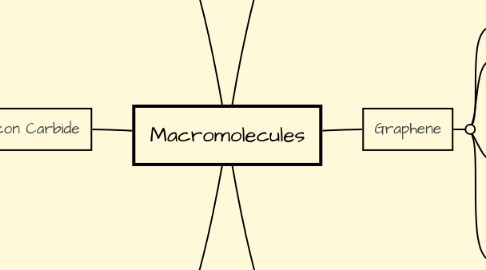
1. Diamond
1.1. Appearance
1.1.1. Hard transparent crystal
1.2. Structure
1.2.1. Giant covalent structure
1.3. General porperties
1.3.1. Conductivity of heat
1.3.1.1. Good conductor
1.3.2. Conductivity of electricity
1.3.2.1. Insulator
1.3.2.1.1. Because there are no free electrons or ions
1.3.3. Boiling and melting point
1.3.3.1. High
1.3.4. Density
1.3.4.1. 3.51g/cm3
1.3.5. Solubility
1.3.5.1. Insoluble in water and organic solvant
1.4. Uses
1.4.1. Grinding, cutting and drilling
2. Silicon Carbide
2.1. Appearance
2.1.1. Hard-balck crystal
2.2. Structure
2.2.1. Giant covalent structure
2.3. General properties
2.3.1. Conductivity of heat
2.3.1.1. Good conductor
2.3.2. Conductivity of electricity
2.3.2.1. Semi-conductor
2.3.3. Boiling and melting point
2.3.3.1. High
2.3.4. Density
2.3.4.1. 3.21g/cm3
2.3.5. Solubility
2.3.5.1. Insoluble in water. Soluble in molten alkalis (NaOH, KOH) and molten iron.
2.4. Uses
2.4.1. Heat exchangers, hot gas flow liners
3. Buckyballs
3.1. Appearance
3.1.1. Dark-needle like crystals
3.2. Structure
3.2.1. Cylindrical covalent structure
3.3. General properties
3.3.1. Conductivity of heat
3.3.1.1. Good conductor
3.3.2. Conductivity of electricity
3.3.2.1. Good conductor
3.3.3. Boiling and melting point
3.3.3.1. High
3.3.4. Density
3.3.4.1. 1.65g/cm3
3.3.5. Solubility
3.3.5.1. Insoluble in water, but soluble in aromatic solvent such as disulfide
3.4. Uses
3.4.1. Use for drug delivery system in the body, as lubricant and catalyst
4. Graphite
4.1. Appearance
4.1.1. Brittle Silver-gray solid
4.2. Structure
4.2.1. Giant covalent structure
4.3. General properties
4.3.1. Conductivity of heat
4.3.1.1. Good conductor
4.3.2. Conductivity of electricity
4.3.2.1. Good conductor
4.3.2.1.1. Graphite contains delocalised electrons. These electrons can move through the graphite, carrying charge from place to place
4.3.3. Boiling and melting point
4.3.3.1. High
4.3.4. Density
4.3.4.1. 2.27g/cm3
4.3.5. Solubility
4.3.5.1. Insoluble in water and organic solvant
4.4. Uses
4.4.1. Steel manufacturing
5. Graphene
5.1. Appearance
5.1.1. Black powder/crystal
5.2. Structure
5.2.1. crystalline allotrope structure
5.3. General properties
5.3.1. Conductivity of heat
5.3.1.1. Good conductor
5.3.2. Conductivity of electricity
5.3.2.1. Good conductor after electrons are delocalized
5.3.3. Boiling and melting point
5.3.3.1. High
5.3.4. Density
5.3.4.1. 1.5g/cm3
5.3.5. Solubility
5.3.5.1. Soluble in water
5.4. Uses
5.4.1. Lower-cost fuel cell and solar cell
6. Silicon dioxide
6.1. Appearance
6.1.1. White powder/crystal
6.2. Structure
6.2.1. Giant covalent structure
6.3. General properties
6.3.1. Conductivity of heat
6.3.1.1. Good conductor
6.3.2. Conductivity of electricity
6.3.2.1. Doesn't conduct electricity
6.3.2.1.1. Because there are no free electrons or ions
6.3.3. Boiling and melting point
6.3.3.1. High
6.3.4. Density
6.3.4.1. 2.65g/cm3
6.3.5. Solubility
6.3.5.1. The solubility of silicon dioxide in water strongly depends on its crystalline form
6.4. Uses
6.4.1. In supplements, it's used to prevent the various powdered ingredients from sticking together.

